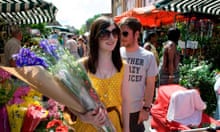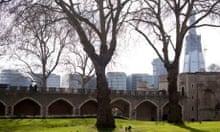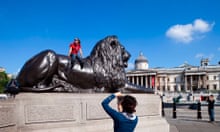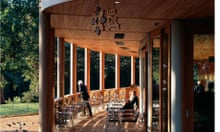Last September I went on an eight-day hiking holiday with three friends. Shouldering rucksacks with tent and sleeping bags, we set off – by strolling through Hackney's Victoria Park. We weren't straying far from home: our route was the Capital Ring, a 78-mile loop around London that can be done in 15 one-day walks. So why the tent?
This wasn't just a hike; this was also an investigation into whether London works as a community. The four of us met through our involvement with a children's educational camping charity. We regularly go hiking in the wilds with kids and wondered whether the practice of knocking on farmers' doors and asking to camp in their field could work on the famously aloof inhabitants of this metropolis.
We discussed ground rules, the principle one being that we had to stay with strangers that we met en route. We would walk for about 10 miles a day and at mid-afternoon start scouting around for a place to pitch our tent for the night. It was daunting, but as we were only ever about an hour away from our own beds, it wasn't like arriving in Mumbai at 2am.
So, on a sunny September morning, we hit the pavements. We didn't need to pack food or even plan a map route – all we had to do was decide whether to turn left or right when we joined the Capital Ring at Hackney Wick, then follow the green signposts.
The Capital Ring is an easily navigable walk that connects some of the extraordinary nooks, crannies and enormous green spaces of London. It passes through nature reserves, sites of special scientific interest, grand country estates and along rivers and canals. Between the architectural and green gems, there are, however, dull recreation grounds, neglected waterways and road works.
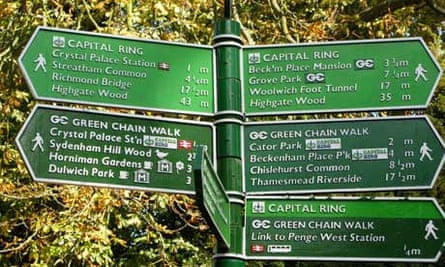
Day one started with a feisty discussion about the Olympics as we passed the construction site. Then the Greenway through Bow towards Newham, which goes along the top of a rebranded (but wiffy) historic Bazalgette sewer. Heavy rain kicked in as we headed towards the Woolwich Ferry across the Sir Steve Redgrave Bridge (across the Royal Albert Dock). This turned out to be more drawbridge than road bridge: HMS Dauntless was waiting to be tugged out into the river. As the road rose vertically ahead of us we decided to skip the ferry and two hours waiting in the rain and took the Docklands Light Railway across the river via Canning Town to Woolwich Arsenal instead. This is the upside of urban hiking – we dried off on the train, ate home-grown pears given to us by a lovely man in Beckton and recharged with a cappuccino at the other end. You can't do that on a Yorkshire moor.
Our destination for the first night was Oxleas Woods in Eltham, an ancient and magnificent expanse of nature moments from intensely urban life, populated with stunning native British trees (oak, silver birch, hornbeam, hazel and wild service).
Even though wild camping in London is technically illegal without permission, we weren't ready to test our stranger-charming skills yet. So after six hours of walking, we bedded down deep in the 8,000-year-old beauty of Oxleas Woods, lulled by the soundtrack of an all-night car park party and the A207 just minutes away.
A broken night, but we recharged with a mighty vegetarian full English at Oxleas Cafe (oxleawoodcafe.info), looking out over the North Downs, before heading off through the woods again. We spotted rose-ringed parakeets – now an exotic staple of London birdlife – and a green woodpecker, and discovered a curious mixture of major roads, royal palaces (Eltham) and lovely locals including Bob, who sold us some runner beans from his allotment for our supper.
Early on we decided that if we met strangers on neutral territory rather than knocking on doors we would feel less like cold callers. We tries this out in Beckenham Place Park and were astonished that of the first four people we approached, three offered us their gardens (the fourth lived in a flat). What we thought would be a bizarre question to a hardened Londoner was proving quite acceptable.
Jason in Catford was our first, wonderful host, followed by other kind souls in Streatham, Brentford, Harrow and Muswell Hill. We met them in parks, pubs and by knocking on their doors but however we found them we quickly developed a synergistic relationship. We invited them into our bizarre adventure and they welcomed us into their homes. They showed us their generosity with physiotherapy tips, frangipane baked delights, under-floor heating for our tent on an old bonfire site, freshly baked bread, real coffee and single malts. We offered a service in return; cooking dinner for them in their gardens, cleaning windows and even reseeding a lawn. But it was about more than chores; the exchange of fun, adventure and curiosity made us all smile.
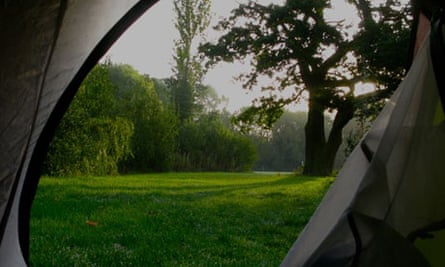
The award for the most unlikely campsite has to go to Harrow-on-the-Hill on our penultimate night. Having just learned that the entire area is owned by Harrow School, we approached the school office expecting to be sent packing. Fortuitously we met just the right man, a school security guard who had participated in a "kindness of strangers" adventure himself a few years before. We got permission to camp beside a rugby pitch with a view of the school's herd of rare-breed cattle. Truly bizarre.
Other highlights of the route: the two days of relatively rural bliss crossing Wimbledon Common and Richmond Park and the sloe-laden hedgerows of Fryent Country Park. The idyllic beauty of the Brent river when it parts company with the Grand Union at the foot of Hanwell Locks, and Brunel's magnificent Wharncliffe viaduct. It's wonderful that the green corridors of the Brent have been preserved, but their proximity to the North Circular (the noisiest road in Britain, carrying 85,000 vehicles a day) means keeping them green and clean is a challenge, one mainly taken on by local groups rather than councils. Amazingly, the rich bird life on the Brent reservoir seemed unbothered by the A406 – we counted 20 species while having lunch.
One thing we hadn't anticipated was the effect of eight days' walking on hard surfaces (the majority of the Capital Ring walk is wheelchair accessible) on our feet. They were pretty mangled by the end. We also discovered that for four women in one tent, seven nights is about the limit, be you ever such good friends.
I'm a lifelong Londoner, but when you live and work in a place it's easy to tread routine paths and not look beyond. We had decided to learn and discover more about our city. But a city is as much about the people as the place, so we broke London's cardinal rule: we looked strangers in the eye and brazenly spoke to them. And guess what? They actually quite liked it.
Mild indifference was the worst reaction we had to our requests for a place to pitch, and this only happened in more affluent areas. Our high success rate can't just be down to luck – it has to show that people are happy to help if they can. But they did tend to be more understanding when we were carrying our rucksacks. Without them we seemed merely badly dressed and a bit smelly.

